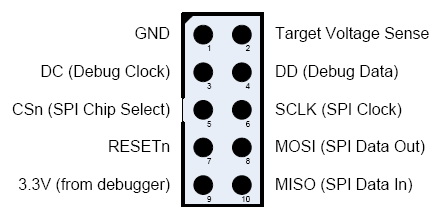mirror of
https://github.com/Koenkk/zigbee2mqtt.git
synced 2024-11-17 10:58:31 -07:00
121 lines
3.9 KiB
Markdown
121 lines
3.9 KiB
Markdown
# Alternative flashing methods
|
|
|
|
### Via Arduino/ESP8266
|
|
Flashing firmware via Arduino is implemented using the project https://github.com/wavesoft/CCLib
|
|
**But with minor improvements!!!**
|
|
|
|
[AndrewLinden](https://github.com/AndrewLinden) described that he was able to flash CC2531 using CCLib [with comments](https://github.com/wavesoft/CCLib/issues/19).
|
|
|
|
As described [I made a fork of the CCLib library with minor changes](https://github.com/kirovilya/CCLib) for flashing firmware via Arduino:
|
|
|
|
* Timeouts of operations
|
|
* After opening the port (I have in Windows 7) Arduino reboots and, accordingly, does not respond to requests - made a 3 seconds pause (found somewhere in internet).
|
|
* The port speed is reduced to 9600, because at another speed leaving communication errors:
|
|
`ERROR: Could not read from the serial port!`
|
|
|
|
Flashing proccess:
|
|
1. Download and unpack the archive with the library https://github.com/kirovilya/CCLib.
|
|
|
|
2. Flashing Arduino sketch via Arduino IDE
|
|
CCLib\Arduino\CCLib\Examples\CCLib_proxy\CCLib_proxy.ino
|
|
|
|
**If flashing via esp8266 (wemos d1 mini), you need change connection (p. 5) and Pinout configuration in Arduino/CCLib/Examples/CCLib_proxy/CCLib_proxy.ino:**
|
|
```
|
|
int CC_RST = 5;
|
|
int CC_DC = 4;
|
|
int CC_DD_I = 14;
|
|
int CC_DD_O = 12;
|
|
```
|
|
|
|
3. Install Python 2.7 or later (tested with python 2.7.13), if not installed
|
|
|
|
4. Install pyserial 3.0.1, if not installed
|
|
`pip install -r CCLib\Python\requirements.txt`
|
|
or
|
|
`pip install pyserial==3.0.1`
|
|
|
|
5. Connect the contacts as described https://github.com/kirovilya/CCLib#1-prepare-your-arduino-board
|
|
**But in my case, I connected completely without resistors, combined the contacts CC_DD_I and CC_DD_O together and connected to the DD pin of the DEBUG connector!**
|
|
|
|

|
|
|
|
I connected only 3 specified contacts and GND. During the firmware, the stick and Arduino must be connected to the USB.
|
|
|
|

|
|

|
|

|
|
|
|
6. After that, try to get information about the chip - if it works, then the connection is correct (example for COM9 port - Arduino port):
|
|
|
|
```
|
|
C:\Projects\CCLib\Python>python cc_info.py -p COM9
|
|
INFO: Found a CC2531 chip on COM9
|
|
|
|
Chip information:
|
|
Chip ID : 0xb524
|
|
Flash size : 256 Kb
|
|
Page size : 2 Kb
|
|
SRAM size : 8 Kb
|
|
USB : Yes
|
|
|
|
Device information:
|
|
IEEE Address : 00124b0014aa
|
|
PC : 0000
|
|
|
|
Debug status:
|
|
[ ] CHIP_ERASE_BUSY
|
|
[ ] PCON_IDLE
|
|
[X] CPU_HALTED
|
|
[ ] PM_ACTIVE
|
|
[ ] HALT_STATUS
|
|
[ ] DEBUG_LOCKED
|
|
[X] OSCILLATOR_STABLE
|
|
[ ] STACK_OVERFLOW
|
|
|
|
Debug config:
|
|
[ ] SOFT_POWER_MODE
|
|
[ ] TIMERS_OFF
|
|
[X] DMA_PAUSE
|
|
[X] TIMER_SUSPEND
|
|
```
|
|
[Another example of connection on MacOS](https://github.com/wavesoft/CCLib/issues/22#issuecomment-384452424)
|
|
|
|
7. If everything is successful, then download [modified firmware for flashing via Arduino](https://github.com/kirovilya/files/blob/master/CC2531ZNP-Pro-Secure_LinkKeyJoin_mod.hex)
|
|
|
|
8. Start the flashing firmware (it takes a long time, about 2-3 hours):
|
|
|
|
```
|
|
C:\Projects\ZigBee>python cc_write_flash.py -e -p COM9 --in=CC2531ZNP-Pro-Secure_LinkKeyJoin_mod.hex
|
|
INFO: Found a CC2531 chip on COM9
|
|
|
|
Chip information:
|
|
Chip ID : 0xb524
|
|
Flash size : 256 Kb
|
|
Page size : 2 Kb
|
|
SRAM size : 8 Kb
|
|
USB : Yes
|
|
Sections in CC2531ZNP-Pro-Secure_LinkKeyJoin_mod.hex:
|
|
|
|
Addr. Size
|
|
-------- -------------
|
|
0x0000 8176 B
|
|
0x1ff6 10 B
|
|
0x3fff0 1 B
|
|
0x2000 239616 B
|
|
|
|
This is going to ERASE and REPROGRAM the chip. Are you sure? <y/N>: y
|
|
|
|
Flashing:
|
|
- Chip erase...
|
|
- Flashing 4 memory blocks...
|
|
-> 0x0000 : 8176 bytes
|
|
Progress 100%... OK
|
|
-> 0x1ff6 : 10 bytes
|
|
Progress 100%... OK
|
|
-> 0x3fff0 : 1 bytes
|
|
Progress 100%... OK
|
|
-> 0x2000 : 239616 bytes
|
|
Progress 100%... OK
|
|
|
|
Completed
|
|
``` |